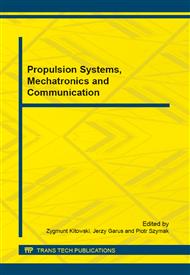[1]
C. E. Baum: On the Use of Contour Integration for Finding Poles, Zeros, Saddles and Other Function Values in the Singularity Expansion Method, Air Force Weapons Laboratory, (1974).
Google Scholar
[2]
B. K. Singaraju, D. V. Giri, and C. E. Baum: Further Developments in the Application of Contour Integration to the Evaluation of the Zeros of Analytic Functions and Relevant, Computer Programs. Air Force Weapons Laboratory, (1976).
Google Scholar
[3]
J. M. Meyers, S. S. Sandler, and T. T. Wu, Electromagnetic resonances in a straight wire, IEEE Trans. Antennas Propag., vol. 59, no. 1, Jan. (2011).
Google Scholar
[4]
S. W. Lee and B. Leung: The Natural Resonance Frequency of a Thin Cylinder and its Application to EMP, Studies Interaction Notes, Note 96, (1972).
Google Scholar
[5]
L. A. Weinstein: The Theory of Diffraction and the Factorization Method. Boulder, CO: The Golem Press, (1969).
Google Scholar
[6]
L. Shen, T. Wu, and R. W. P. King: A simple formula of current in dipole antennas, IEEE Trans. Antennas Propag., vol. AP–16, no. 5, (1968).
DOI: 10.1109/tap.1968.1139241
Google Scholar
[7]
A. Hoorfar and D. C. Chang, Analytic determination of the transient response of a thin-wire antenna based upon an SEM representation, IEEE Trans. Antennas Propag., vol. AP-30, no. 6, Nov. (1982).
DOI: 10.1109/tap.1982.1142959
Google Scholar
[8]
E. Hallén: Über Die Elektrischen Schwingungen in Drahtförmigen Leitern" ("On the Electrical Oscillations in Wire-Like Conductors, ). Uppsala, Sweden, Uppsala Univ. Ärsskritt, 1930, vol. 1, p.1–102.
Google Scholar
[9]
C. J. Bouwkamp: Hallén's theory for a straight, perfectly conducting wire, used as a transmitting or receiving aerial, Physica IX, vol. 7, p.609–631, Jul. (1942).
DOI: 10.1016/s0031-8914(42)80028-2
Google Scholar
[10]
L. Marin and T. K. Liu: A simple way of solving transient thin-wire problems, Radio Sci., vol. 1, no. 2, p.149–155, Feb. (1976).
DOI: 10.1029/rs011i002p00149
Google Scholar
[11]
B. Gustavsen, A. Semlyen: Rational approximation of frequency domain responses by Vector Fitting, IEEE Transactions on Power Delivery, 1999, vol. 14, no. 3, pp.1052-1061.
DOI: 10.1109/61.772353
Google Scholar
[12]
B. Gustavsen: Improving the pole relocating properties of Vector Fitting, IEEE Transactions on Power Delivery, 2006, vol. 21, no. 3, pp.1587-1592.
DOI: 10.1109/tpwrd.2005.860281
Google Scholar
[13]
S. Grivet-Talocia, M. Bandinu: Improving the convergence of Vector Fitting for equivalent circuit extraction from noisy frequency responses, IEEE Transactions on Electromagnetic Compatibility, 2006, vol. 48, no. 1, pp.104-120.
DOI: 10.1109/temc.2006.870814
Google Scholar
[14]
Se-Jung Moon, Xiaoning Ye, A. Cangellaris: Efficient time-domain Vector Fitting for broadband interconnect modelling, IEEE International Symposium on Electromagnetic Compatibility (EMC), 25-30 July 2010, Fort Lauderdale, FL, pp.563-567.
DOI: 10.1109/isemc.2010.5711338
Google Scholar
[15]
R. Prony: Essai éxperimental et analytique: sur les lois de la dilatabilité de fluides élastique et sur celles de la force expansive de la vapeur de l'alkool, à différentes températures, " Journal de l, École Polytechnique Floréal et Plairial, an III (1795), vol. 1, cahier 22, 24-76.
DOI: 10.1017/cbo9780511702280.018
Google Scholar
[16]
M. L. Blaricum, R Mittra: A technique for extracting the poles and residues of a system directly from its transient response, IEEE Transactions on Antennas and Propagation, 1975, vol. 23, no. 6, pp.771-781.
DOI: 10.1109/tap.1975.1141184
Google Scholar
[17]
S. M. Rao: Time Domain Electromagnetics, Academic Press, London, (1999).
Google Scholar
[18]
B.H. Jung, T.K. Sarkar: Time-domain electric-field integral equation with central finite difference, Microwave and Optical Technology Letters, 2001, vol. 31, no. 6, pp.429-434.
DOI: 10.1002/mop.10055
Google Scholar


